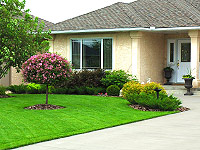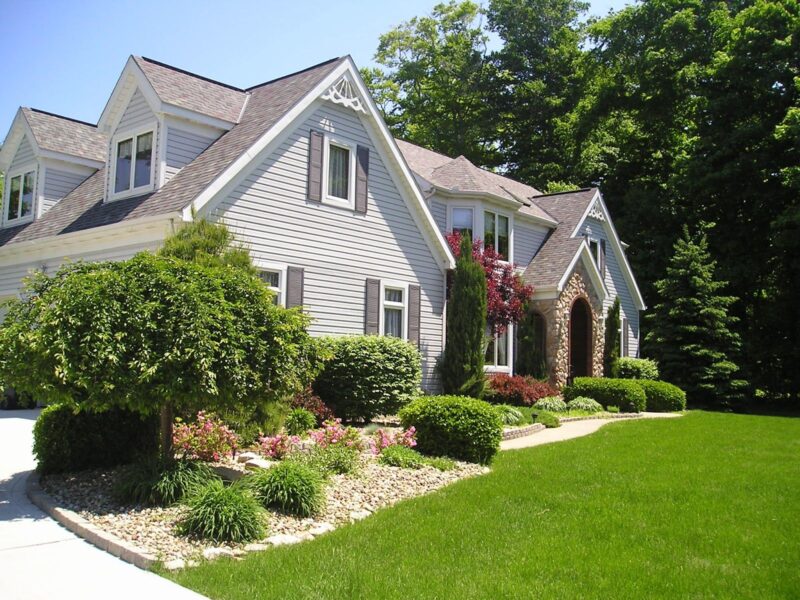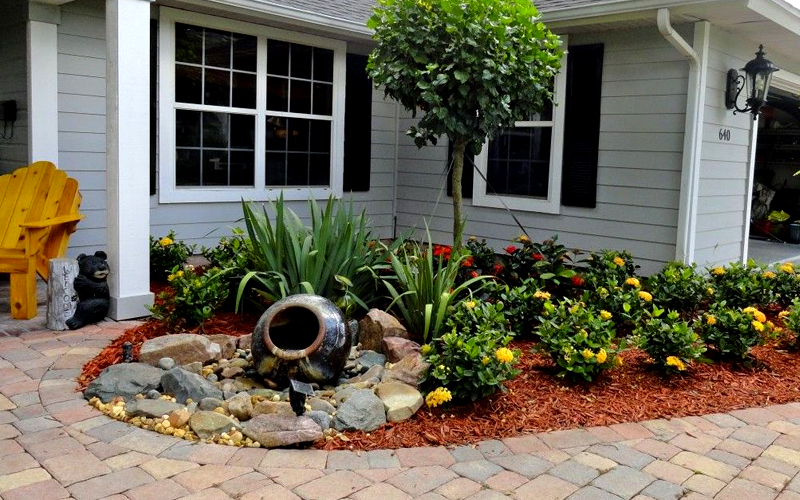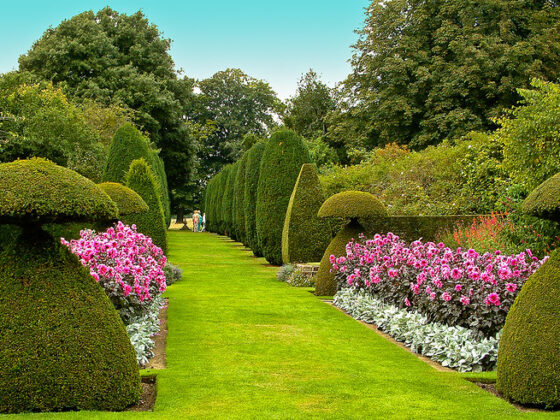You drive by a well-landscaped house. You intuitively know that you like what you see, although you may not be certain exactly what it is about this particular landscape that has caught your attention.
All you know is that it looks good; it’s in balance, the attractive features of the home are accentuated and complemented without being hidden or overwhelmed, and everything seems to fit. Chances are this landscape effectively used a front yard accent plant, one of the fundamentals of an effective landscape composition.
We’ve all seen front yard accent plants in use, whether we’ve noticed them or not. These are the highly ornamental plants that sit in front of or slightly to the side of the principal front window or main entrance of the home.
In a pleasing landscape composition, they are in balance with the scale, color, and texture of the house. They usually stand-alone or tower above a smaller garden and are given ample room to reveal their attractive form and ornamental features to their fullest.
Front yard accent plants perform a very specific function in the landscape. Because by definition they are situated in the front of the home, they are the cornerstone of what’s known as the “public” side of your landscape, the part of your landscape that’s designed for the outside world to enjoy and marvel at.
This is part of your landscape that tells the rest of the world much about you; how you value your home and your property, your artistic preferences, your eye for beauty, and your tastes in color and style. It’s no different than the clothes you wear; they too tell the world much about you as a person.
Your front yard is the hallmark of your personality. A clean, well-designed front landscape states unequivocally that you treasure your home and yard, and reveals you as a tasteful, interesting, meticulous, and orderly person.
On the other hand, a poorly designed front landscape will give others the message that you don’t care, that you are boring and lazy, or at worst, tasteless and slovenly.
That’s why you want to pay close attention to the front yard and apply the techniques and methods that underpin an effective front landscape design. And that means you’ll need to understand the inner workings of front yard accent plants.

So how do front yard accent plants work in a landscape? In an effective design, they are typically the second thing your eye will be drawn to, behind only the house itself. Together house and the accent plants engage in a subtle artistic dance, each vying for your attention while complementing the other completely.
In turn, the balance of the landscape would seem to exist in a supporting role to these two key elements, never detracting from their beauty and never compromising their features.
And this is the key to the effective use of a front yard accent plant; it must work in tandem with the house, neither overwhelming it nor diminishing it in any way, yet standing apart from the rest of the landscape.
That means that it must be interesting in its own right, possessing one or more ornamental attributes while suffering from few or no negative characteristics. That also means that it must originate from the same style as the house and the overall landscape.
It must be harmonious with the house in the fundamental design principles of color, form, and texture, either complementing or in contrast to it, but always deliberately so. And the exact location of this plant is critical.
Attributes of a Good Accent Plant
What makes a good front yard accent plant? This is a fantastic question, and I’m glad you asked. Simply put, they must be uniquely ornamental with as few negative attributes as possible.

It helps to think of them in relation to all the other plants in your yard. They must be the most singularly ornamental of all your plants, the ultimate expression of one or more of the basic design attributes in your yard.
On the other hand, they should maintain an acceptable minimum threshold of all of these characteristics across all four seasons and have few if any bad habits or times of the year when they detract from the composition. It sounds like a lot to ask, but you’ll be surprised to learn that there are many plants that fit this description, even in the North.
Let’s have a look at the interest, a key objective of good landscape design. Interest is the currency of your landscape; the richest landscapes are interesting every month of the year and as viewed from all perspectives, from both one hundred feet away and twelve inches away.
interest is dynamic and ever-changing because even the most interesting feature becomes boring over time. In a landscaping sense, interest is derived from the fundamental attributes of color, form, and texture. Therefore, good accent plants must possess ornamental qualities from at least one of these attributes.
Accent plants can be extremely colorful at times of the year, providing either complementary or contrasting colors that stand apart from the background of the landscape and which are harmonious with the external colors of the house.
Feature plants with colorful flowers include flowering crabs (Malus cv.), ornamental plums (Prunus cv.) and pears (Pyrus ussuriensis and P. calleryana cv.), hawthorns (Crataegus spp.), redbuds (Cercis canadensis) and tree lilacs (Syringa reticulata cv.).

Color can be vividly expressed in fall with the fiery Amur maple (Acer ginnala), staghorn sumac (Rhus typhina), or apple serviceberry (Amelanchier x grandiflora).
Colorful summer or variegated foliage is found in the Newport plum (Prunus ‘Newport’) and Golden Eclipse tree lilac (Syringa reticulata ‘Golden Eclipse’). Color can also come from the bark, with plants such as paper birch (Betula papyrifera), river birch (B. nigra), or Amur cherry (Prunus maackii).
Accent plants can possess a unique shape that contrasts with the rigid linearity of the house or which stands apart from the silhouette of the landscape skyline.
Arching or weeping plants such as weeping crabs (Malus ‘Red Jade’, ‘Royal Beauty’ or ‘Rosy Glo’), birch (Betula pendula ‘Dalecarlica’ and ‘Youngii’) pea shrubs (Caragana arborescens ‘Walker’) or larches (Larix decidua ‘Pendula’) stand in sharp contrast to the strong lines of most homes.
Horizontally spreading or layered plants like pagoda dogwood (Cornus alternifolia), cockspur hawthorn (Crataegus crus-galli), or Japanese tree lilac (Syringa reticulata cv.) offer a subtle foil to the vertical lines of man-made structures.
On the other hand, rigidly upright plants like columnar hornbeam (Carpinus betulus ‘Fastigiata’) and Spring Snow flowering crab (Malus ‘Spring Snow’) will punctuate the horizontal flow of a long, low bungalow or rambler.
Accent plants can feature textures that are in sharp contrast to those of the home and the contiguous landscape background.
The shockingly coarse textures of northern and Chinese catalpa (Catalpa speciosa and C. ovata, respectively) stand out from a great distance, while the bold yet ferny texture of cut leaf smooth and staghorn sumac (Rhus glabra ‘Laciniata’ and R. typhina ‘Laciniata’, respectively) lend an almost tropical air to the composition.
On the other side of the spectrum, finely textured plants such as cut-leaf pea shrubs (Caragana arborescens ‘Lorbergii’) and cut-leaf alder (Alnus glutinosa ‘Imperialis’) stand apart from a conventional garden composition.

Aside from deriving interest through their ornamental qualities, front-yard accent plants must also be judged on the merits of their non-ornamental performances. They must maintain a minimum of acceptability in all the design attributes at all times, especially when they are not at the peak of their ornamental performances.
So, for example, a plant that is individually stunning in bloom would be a poor choice as an accent if it defoliates in the heat of summer or if it looks ragged and shrubby the rest of the year.
Scale is important as well. Front yard accent plants must be in scale with both the house and the background of the landscape composition.
They must neither tower above the house nor rise over the background landscape and yet they must deliver an impact from some distance (e.g. from the road). A good rule of thumb would be a mature height equal to the height of the roof line (the very highest point) of the house, and down to half that size.
As such, the most common accent plants are either small trees or large shrubs for single-level homes, and small to medium-sized trees for two-story homes. Very few perennials and even fewer annuals are candidates for accent plants, although there are one or two notable exceptions such as the ubiquitous castor bean which is grown for its incredibly coarse foliage.
And finally, accent plants should generally be deciduous, with only a few exceptions. Evergreens by definition change very little over the year, and as such are limited in their ability to deliver dynamic interest in a landscape composition.
They also tend to lack dominant ornamental features such as showy flowers or colorful bark, again with specific exceptions. More often than not, though, they make excellent background plants to the deciduous accents, providing a constant foil that further emphasizes the dynamic performance of the feature plant.
Designing For Accents In The Landscape
Now that you know what makes a good candidate for a front yard accent plant, how is it integrated into the overall landscape design? First and foremost, an accent must stand out and apart from the rest of the landscape. To stand out, it must be unique.
This means that there should only be one plant performing the function of a front yard accent in any landscape. And, the specific accent plant should only be used once in the entire landscape, again to keep it unique and interesting by virtue of its difference from the rest of the landscape.

A common and terrible mistake made by many amateur home landscapers is to load the landscape with “accents”, premised on the thinking that “if one is good, more must be better”. Nothing could be further from the truth; one plant is an accent, while many become commonplace. Any more than a single use of an accent plant, and it is no longer a point of interest.
Accent plants should be given adequate room to grow freely and should never be crowded. Besides the fact that most have desirable growth habits throughout their lifetimes which would be compromised by competition from other plants, they are visually more impressive when they rise out of the front landscape and grow unchallenged, not suffering from any visual competition.
They must be vertically dominant in their planting space, either rising from the very ground or anchored with a low and non-competitive garden. Remember, visually they must stand alone to be maximally effective, and should only be diminutive to the house and the distant background.
The placement of an accent plant with respect to the house is critical, and the key to determining the location comes from the primary lines of sight. First and foremost, the accent plant must be visible in all its splendor to the outside world. That can be from the street, a sidewalk, a lake, or river, etc.
When viewed from this primary public perspective, the accent plant should be situated such that it is in front of or relatively close to the front of the house, without obstructing the view of the key features of the house, which are typically the front door or entranceway, the front window and any other specific features of interest that you wish to highlight. Obviously, this is not possible from all angles, so choose one that will be the most viewed from off your property.
Along this line of sight, the view of both the accent and the house should be relatively unobstructed. As such, all plants to the front of the accent should be significantly lower (no more than 1/4 of the height of the accent plant) and visually less competitive.
A low uniform hedge is acceptable, while another tree in the line of sight would defeat the purpose of the accent. Moving away from and to the sides of the line of sight, other elements can be gradually introduced into the vista, but try to keep them in context. For example, you might use large trees to frame the view, but which give way to an unobstructed line of sight where critical.
The accent plant must also be strategically sited on the property from an overhead perspective. The exact placement depends to a great degree on the individual circumstances, but general rules of thumb apply.
Where practical, it should be located along the critical line of the site at a minimum of 10′ from the house up to a distance of about 30′, with adjustments for scale (i.e. closer for a smaller house or property, further for a larger house or property). Any closer and it will appear as part of the foundation planting, and any further and it will seem disconnected from the house.

Placement with respect to other landscape features is less critical but should be considered nonetheless. Obviously, the background must be behind the accent from all critical viewpoints.
The accent plant can be apart from key access ways such as sidewalks and driveways, or it can be near them; if so, it should be planted into a context that works from the immediate perspective of the access way as well as from the outside view. Often a small or low garden is used to visually anchor the tree to the ground on close inspection, while not competing with it from a distance.
You will also want to examine the location of the accent plant from perspectives on your property looking outside and off your property.
Examine it from inside your house looking out, and from strategic points on your property such as sidewalks and gardens where people tend to move or congregate. Will it draw the eye away from or hide an undesirable external view (good) or will it conceal a particularly attractive vista (bad)?
Special Challenges
The above discussion has examined the basics of landscape design for front yard accent plants in a general sense. Obviously, every individual landscape is different and has unique circumstances which must be taken into account in the final design plan. I’ll look at a specific few cases and give you suggestions as to how they affect the decisions you will make.

Many people, especially avid gardeners who are pressed for space or who can’t restrain their passions, like to crowd their front yards with busy gardens.
Besides the fact that these will inevitably draw the eye away from the house, they introduce a level of activity to the public view that will make it a challenge for any accent plant to stand apart.
Unfortunately, a plethora of individually stunning gardens doesn’t necessarily make for effective landscape composition. If it’s absolutely necessary to work with such a scenario, be sure that the gardens step down in height and diminish in interest moving away from the accent plant and towards the external viewer.
There is a growing trend in modern landscaping towards low maintenance and “no lawn” landscapes, even in the front yard. In principle, such landscapes don’t alter the basic design requirements for front yard accent plants. However, the alternative layouts of such landscapes can introduce special considerations.
For example, many of these landscapes tend to be busier, especially in a vertical context. Often these landscapes draw attention to the “solution” in the front yard, thereby drawing the eye away from the house and the accent plant and complicating the clean objectives of the public view.
It is doubly important in these cases to stick to your guns and design the accent to stand apart. Optimally, you will have designed this low-maintenance lawn alternative to be unassuming, uniform, and contiguous, grounding the house to the earth rather than competing with it for attention.
If not, then you might want to choose one specific aspect of the hardscape and turn it into a “faux” accent, adhering to the above rules wherever possible. Still, there is no substitute for a dynamic accent plant in this critical position, something you may want to consider changing in the future.
I have seen many people attempt to introduce hard landscaping elements into the role of front yard accents, such as fountains, statuary, boulders, waterfalls, etc. More often than not, such attempts fail, for a variety of reasons. First of all, any hardscaping element that is in proper scale with the house would be visually jarring and will almost always look gaudy or artificial.
Besides, such features almost always tear the eye away from the house and are hard to make complementary to the style. I mean, what aspect of a house is complemented by a massive fountain or giant statue, short of a formal Italian courtyard?
Don’t get me wrong, I’m not advocating that these not be used at all. But where they are used, they must be in scale with the house and not detract from it, and for that reason, they cannot perform the function of a front yard accent. You are better off designing them into a small feature garden where they will more blend in than stand apart, and introduce an accent plant as the front yard feature.
Not all properties are the same size and shape and are not all nicely rectangular with a clear view of the street. Regardless, the basic rules apply, with one becoming even more critical; scale. If the front yard is narrow, the accent plant must be scaled down appropriately. It’s the same if the front yard is shallow. On the other hand, a particularly wide or deep front yard will warrant a scaling up of the plant size.
The tradeoff in all of these cases is keeping scale with the house. A very low, long bungalow on a park-sized property may require a grouping of accent plants (always odd numbers!) for effect, while a tall, upright row-house on a narrow lot may benefit from a narrowly upright oval tree that is tall to keep the scale with the house yet rounded enough to offset the vertical lines.
And with that, you now have the basic understanding and tools to properly select and situate a front yard accent plant in your landscape. If you don’t already have one, think about this; this single plant along with a little planning will deliver more of an impact on your landscape than any other plant you will ever introduce. So what are you waiting for?














